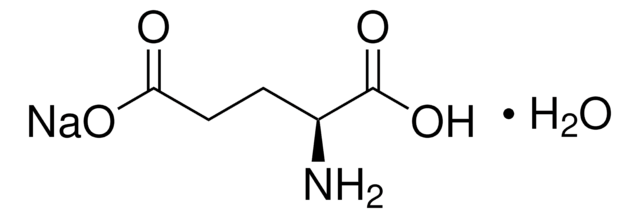G1626
L-Glutamic acid monosodium salt hydrate
≥99% (HPLC), powder
Synonim(y):
(S)-2-Aminopentanedioic acid, L-Glutamic acid monosodium salt, Glu, MSG, Monosodium glutamate
About This Item
Polecane produkty
Próba
≥99% (HPLC)
Postać
powder
kolor
white to off-white
InChI
1S/C5H9NO4.Na.H2O.H/c6-3(5(9)10)1-2-4(7)8;;;/h3H,1-2,6H2,(H,7,8)(H,9,10);;1H2;
Klucz InChI
JYDGDQPVBSBYRT-UHFFFAOYSA-N
informacje o genach
human ... GRIK1(2897) , GRIK2(2898) , GRIK3(2899) , GRIK4(2900) , GRIN1(2902) , GRIN2A(2903) , GRIN2B(2904) , GRIN2C(2905) , GRIN2D(2906) , GRIN3A(116443) , GRIN3B(116444) , GRINA(2907)
mouse ... GRIK1(14805) , GRIK2(14806) , GRIK3(14807) , GRIK4(110637) , GRIN1(14810) , GRIN2A(14811) , GRIN2B(14812) , GRIN2C(14813) , GRIN2D(14814) , GRIN3A(242443) , GRIN3B(170483) , GRINA(66168)
rat ... GRIK1(29559) , GRIK2(54257) , GRIK3(298521) , GRIK4(24406) , GRIN1(24408) , GRIN2A(24409) , GRIN2B(24410) , GRIN2C(24411) , GRIN2D(24412) , GRIN3A(191573) , GRIN3B(170796) , GRINA(266668)
Szukasz podobnych produktów? Odwiedź Przewodnik dotyczący porównywania produktów
Opis ogólny
Zastosowanie
- as a chemical modulator to rat hippocampal slice cultures for the study of microglial movement post spreading depression (SD) prior to migraine
- as an additive to Neurobasal medium for the growth of embryonic neurons obtained from pregnant mice
- as a component of GYE (glucose yeast extract) solid medium for the growth of four strains of phytopathogen Xylella fastidiosa namely, CVC clone 9a5c, Temecula (Pierce′s disease), Jab1 (Coffee Leaf Scorch), and the isolate 6747 (Plum Leaf Scald), which causes diseases in important crop plants
- as a component of the stock solution for the equilibration of intracellular and extracellular [H+] in segmental nerves obtained from the ventral ganglion of Drosophila larvae
- as a supplement to RPMI (Roswell Park Memorial Institute) medium 1640 used to maintain K562 cell cultures with twice-weekly passage
Działania biochem./fizjol.
Kod klasy składowania
11 - Combustible Solids
Klasa zagrożenia wodnego (WGK)
WGK 2
Temperatura zapłonu (°F)
Not applicable
Temperatura zapłonu (°C)
Not applicable
Środki ochrony indywidualnej
Eyeshields, Gloves, type N95 (US)
Certyfikaty analizy (CoA)
Poszukaj Certyfikaty analizy (CoA), wpisując numer partii/serii produktów. Numery serii i partii można znaleźć na etykiecie produktu po słowach „seria” lub „partia”.
Masz już ten produkt?
Dokumenty związane z niedawno zakupionymi produktami zostały zamieszczone w Bibliotece dokumentów.
Nasz zespół naukowców ma doświadczenie we wszystkich obszarach badań, w tym w naukach przyrodniczych, materiałoznawstwie, syntezie chemicznej, chromatografii, analityce i wielu innych dziedzinach.
Skontaktuj się z zespołem ds. pomocy technicznej




